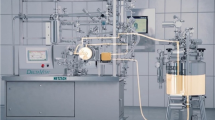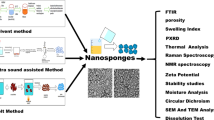Abstract
Drug polymer-based amorphous solid dispersions (ASD) are widely used in the pharmaceutical industry to improve bioavailability for poorly water-soluble compounds. Spray-drying is the most common process involved in the manufacturing of ASD material. However, spray-drying involves a high investment of material quantity and time. Lower investment manufacturing processes such as fast evaporation and freeze-drying (lyophilization) have been developed to manufacture ASD at the bench level. The general belief is that the overall performance of ASD material is thermodynamically driven and should be independent of the manufacturing process. However, no formal comparison has been made to assess the in vivo performance of material generated by different processes. This study compares the in vitro and in vivo properties of ASD material generated by fast evaporation, lyophilization, and spray-drying methods using griseofulvin as a model compound and hydroxypropyl methylcellulose acetate succinate as the polymer matrix. Our data suggest that despite minor differences in the formulation release properties and stability of the ASD materials, the overall exposure is comparable between the three manufacturing processes under the conditions examined. These results suggest that fast evaporation and lyophilization may be suitable to generate ASD material for oral evaluation. However, caution should be exercised since the general applicability of the present findings will need to be further evaluated.





Similar content being viewed by others
REFERENCES
Chiang PC, Chou KJ, Cui Y, Sambrone A, Chan C, Hart R. Evaluation of spray-dried drug load and polymer by using a 96-well plate vacuum dry system for amorphous solid dispersion drug delivery. AAPS Pharm Sci Technol. 2012;13:713–22.
Friesen DT, Shanker R, Crew M, Smithey DT, Curatolo WJ, Nightingale JAS. Hydroxypropyl methylcellulose acetate succinate-based spray-dried dispersions: an overview. Mol Pharm. 2008;5:1003–19.
Chiang PC, Thompson DC, Ghosh S, Heitmeier MR. A formulation-enabled pre-clinical efficacy assessment of a farnesoid X receptor (FXR) agonist, GW4064, in hamsters and cynomolgous monkeys. J Pharm Sci. 2011;100:4722–33.
Lipinski CA. Poor aqueous solubility—an industry wide problem in drug discovery. Am Pharm. 2002;5:82–5.
Lipinski CA. Drug-like properties and the causes of poor solubility and poor permeability. J Pharmacol Toxicol Methods. 2002;44:235–49.
Lipinski, CA. 2003. Physicochemical properties and the discovery of orally active drugs: technical and people issues. Molecular informatics: confronting complexity. Proceedings of the Beilstein-Institut Workshop (Frankfurt, Germany)
Gardner CR, Walsh CT, Almarsson O. Drugs as materials: valuing physical form in drug discovery. Nat Rev Drug Discov. 2004;3:926–34.
Schroter C. Prioritizing molecules based on physicochemical characteristics. Am Pharm. 2006;9:60–7.
Leuner C, Dressman J. Improving drug solubility for oral delivery using solid dispersions. Eur J Pharm Biopharm. 2000;50:47–60.
Anon. New drug development. GAO Report to Congress. GAO-07-49; 2006 November.
Ruben AJ, Kiso Y, Freire E. Overcoming roadblocks in lead optimization: a thermodynamic perspective. Chem Biol Drug Des. 2006;67:2–4.
Gao P. Amorphous pharmaceutical solids: characterization, stabilization, and development of marketable formulations of poorly soluble drugs with improved oral absorption. Mol Pharm. 2008;5:903–4.
Padden BE, Miller JM, Robbins T, Zocharski PD, Prasad L, Spence JK, et al. Amorphous solid dispersions as enabling formulation for discovery and early development. Am Pharm Rev. 2011;14:66–73.
Newman A, Knipp G, Zografi G. Commentary: assessing performance of amorphous solid dispersions. J Pharm Sci. 2012;101:1355–77.
Ivaniscevic I. Physical stability studies of miscible amorphous solid dispersions. J Pharm Sci. 2010;99:4005–12.
Hageman MJ, Miyake PJ, Stefanski KJ, He X, Rohrs BR, Mackin LA, et al. Solid state form of celecoxib having enhanced bioavailability. WO0141536. 2001.
Gupta P, Kakumanu VK, Bansal AK. Stability and solubility of celecoxib-PVP amorphous dispersions: a molecular perspective. Pharm Res. 2004;21(10):1762–9.
DiNunzio JC, Miller DA, Yang W, McGinity JW, Williams III RO. Amorphous compositions using concentration enhancing polymers for improved bioavailability of itraconazole. Mol Pharm. 2008;5:968–80.
Lipinski C, Lombardo F, Dominy B, Feeney P. Experimental and computational approaches to estimate solubility and permeability in drug discovery and development settings. Adv Drug Deliv Rev. 2001;46:3–26.
Hancock B, Parks M. What is the true solubility advantage for amorphous pharmaceuticals? Pharm Res. 2000;17:397–404.
Imaizumi H. Stability and several physical properties of amorphous and crystalline forms of indomethacin. Chem Pharm Bull (Tokyo). 1980;29:983–7.
Kaushal AM, Gupta P, Bansal AK. Amorphous drug delivery systems: molecular aspects, design and performance. Crit Rev Ther Drug Carrier Syst. 2004;21:133–93.
Patel RC, Masnoon S, Patel MM, Patel NM. Formulation strategies for improving drug solubility using solid dispersions. Pharm Rev. 2009;7(6) ISSN: 1918–5561.
Mansky P, Dai W, Li S, Pollock-Dove C, Daehne K, Dong L, et al. Screening method to identify preclinical liquid and semi-solid formulations for low solubility compounds: miniaturization and automation of solvent casting and dissolution testing. J Pharm Sci. 2007;96:1548–63.
Shanbhag A, Rabel S, Nauka E, Casadevall G, Shivanand P, Eichenbaum G, et al. Method for screening of solid dispersion formulations of low-solubility compounds—miniaturization and automation of solvent casting and dissolution testing. Int J Pharm. 2008;351:209–18.
Rumondor ACF, Ivanisevic I, Bates S, Alonzo DE, Taylor LS. Evaluation of drug-polymer miscibility in amorphous solid dispersion systems. Pharm Res. 2009;26:2523–34.
Curatolo W, Nightingale JA, Herbig SM. Utility of hydroxypropylmethylcellulose acetate succinate (HPMCAS) for initiation and maintenance of drug supersaturation in the GI milieu. Pharm Res. 2009;26:1419–31.
Al-Obaidi H, Brocchini S, Buckton G. Anomalous properties of spray dried solid dispersions. J Pharm Sci. 2009;98:4724–37.
Al-Obaidi H, Buckton G. Evaluation of griseofulvin binary and ternary solid dispersions with HPMCAS. AAPS PharmSciTech. 2009;10:1172–7.
Qian F, Zhu JHQ, Haddadin R, Gawel J, Garmise R, Hussain M. Is a distinctive single Tg a reliable indicator for the homogeneity of amorphous solid dispersion? Int J Pharm. 2010;395:232–5.
Newman A, Enger D, Bates S, Ivanisevic I, Kelly R, Zografi G. Characterization of amorphous API:polymer mixtures using x-ray powder diffraction. J Pharm Sci. 2008;97:4840–56.
Murdande SB, Pikal MJ, Shanker RM, Bogner RH. Solubility advantage of amorphous pharmaceuticals: I. A thermodynamic analysis. J Pharm Sci. 2010;99:1254–64.
Murdande SB, Pikal MJ, Shanker RM, Bogner RH. Solubility advantage of amorphous pharmaceuticals: II. Application of quantitative thermodynamic relationships for prediction of solubility enhancement in structurally diverse insoluble pharmaceuticals. Pharm Res. 2010;27:2704–14.
Ivanisevic I, Bates S, Chen P. Novel methods for the assessment of miscibility of amorphous drug-polymer dispersions. J Pharm Sci. 2009;98:3373–86.
Pham TN, Watson SA, Edwards AJ, Chavda M, Clawson JS, Strohmeier M, et al. Analysis of amorphous solid dispersions using 2D solid-state NMR and 1H T1 relaxation measurements. Mol Pharm. 2010;7:1667–91.A.
Newman A, Munson E. Characterizing miscibility in amorphous solid dispersions. Am Pharm Rev. 2012;15:92–8.
Chiang PC, South SA, Daniels JS, Anderson DR, Wene SP, Albin LA, et al. Aqueous vs. non-aqueous salt delivery strategies to enhance oral bioavailability of a mitogen activated protein kinase activated protein kinase (MK-2) inhibitor in rats. J Pharm Sci. 2009;98:248–56.
Wong SM, Kellaway IW, Murdan S. Enhancement of the dissolution rate and oral absorption of a poorly water soluble drug by formation of surfactant-containing microparticles. Int J Pharm. 2006;317:61–8.
Bates TR, Sequeira JA. Bioavailability of micronized griseofulvin from corn oil-in-water emulsion, aqueous suspension and commercial tablet dosage forms in humans. J Pharm Sci. 1975;64:793–7.
Chiou WL, Riegelman S. Preparation and dissolution characteristics of several fast-release solid dispersions of griseofulvin. J Pharm Sci. 1969;58:1505–10.
Chiou WL, Riegelman S. Oral absorption of griseofulvin in dogs: increased absorption via solid dispersion in dogs: increased absorption via solid dispersion in polyethylene glycol 6000. J Pharm Sci. 1970;59:937–42.
Tur KM, Ching HS, Baie S. Use of bioadhesive polymer to improve the bioavailability of griseofulvin. Int J Pharm. 1997;148:63–71.
Chiou WL, Riegelman S. Absorption characteristics of solid dispersed and micronized griseofulvin in man. J Pharm Sci. 1971;60:1376–80.
Gilbaldi M, Perrier D. Pharmacokinetics. 2nd ed. New York: Marcel Dekker; 1982.
ACKNOWLEDGMENTS
The authors would like to give special thanks to Dr. George Zografi for his valuable inputs to the manuscript.
Author information
Authors and Affiliations
Corresponding author
Rights and permissions
About this article
Cite this article
Chiang, PC., Cui, Y., Ran, Y. et al. In Vitro and In Vivo Evaluation of Amorphous Solid Dispersions Generated by Different Bench-Scale Processes, Using Griseofulvin as a Model Compound. AAPS J 15, 608–617 (2013). https://doi.org/10.1208/s12248-013-9469-3
Received:
Accepted:
Published:
Issue Date:
DOI: https://doi.org/10.1208/s12248-013-9469-3




